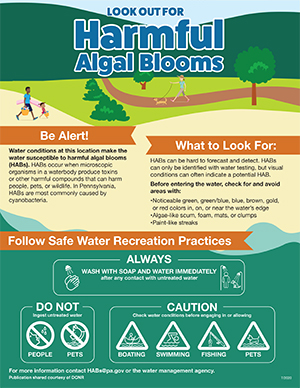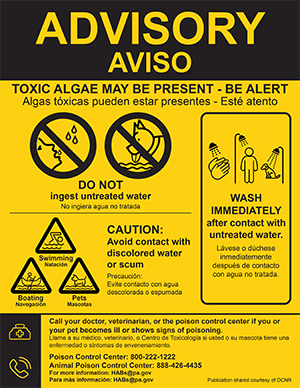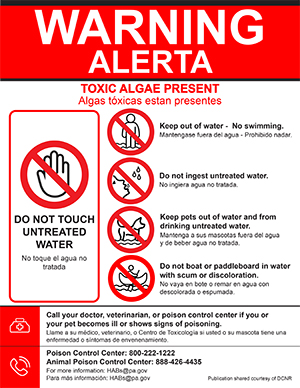What To Do if You Suspect a HAB
If a HAB is suspected or confirmed to be occurring in a body of water, it is strongly recommended for people and pets to follow safe water recreation practices to limit exposure:
- Wash your hands after contact with untreated water
- Shower or bathe people and pets immediately after participating in water-based recreation activities
- Avoid swallowing and inhaling untreated water during recreational activities
- Avoid contact with water that has foam, scum, or discoloration
- Seek and follow any waterbody advisories or closures
If you or your pet becomes ill or shows signs of poisoning after being in or around a waterbody with a suspected or confirmed HAB, call your doctor, veterinarian, or the poison control center: Poison Control Center 800-222-1222; Animal Poison Control Center 888-426-4435.
If you have any health-related questions about HABs, please contact the Division of Environmental Health Epidemiology at the Pennsylvania Department of Health at
env.health.concern@pa.gov. For other inquiries about HABs or to report a suspected HAB, contact the Pennsylvania HABs Task Force at
HABs@pa.gov.
Be on the lookout for HABs
watch,
advisory, and
warning signage.



The Pennsylvania HABs Task Force uses the following
human primary contact recreational use thresholds for four cyanotoxins and for cyanobacterial colony density.
Response level
| Microcystins (µg/L)
| Anatoxin-a (µg/L)
| Cylindrospermopsin (µg/L)
|
Saxitoxins (µg/L)
| Cyanobacteria
colony density (colonies/mL)
|
Advisory (Yellow)
| 8.0 *
| 8 †
| 15 *
| 0.8 †
| 300
|
Avoid Contact (Red)
| 20 †
| 300 †
| 20 †
| 3.0 †
| 1,500
|
*
recommended values from
US EPA 2019
†
thresholds from the
State of Ohio Harmful Algal Bloom Response Strategy for Recreational Waters (see Table 2)
The United States Environmental Protection Agency (US EPA) has also issued the following
10-day drinking water health advisories for two cyanotoxins.
|
Microcystins
|
Cylindrospermopsin
|
Bottle-fed infants and pre-school children
| 0.3*
| 0.7*
|
School-age children and adults
| 1.6*
| 3.0*
|
* recommended values from
US EPA
Here are some additional resources on what you can do if you encounter a suspected or confirmed HAB.
Recreational use resources
Drinking water resources